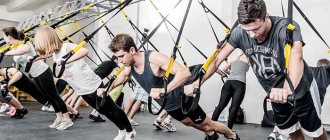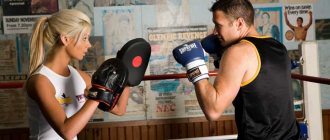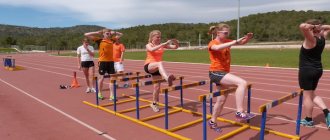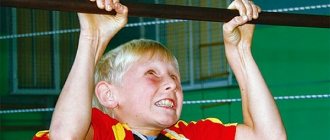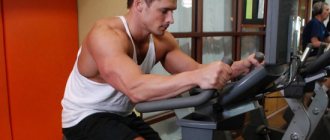They have been trying to transform elements of army training into fitness for a long time: take the same boot-camp, entirely consisting of burpees, push-ups and jumps.
Experts from the ALEX FITNESS network of clubs developed the topic and compiled a functional training program, taking as a basis the training course for elite units of the Russian army (we wrote more about it here). “The main goal of such classes is to comprehensively develop basic physical qualities: strength, endurance, accuracy, coordination,” comments Sergey Privalov, regional manager of gyms in the ALEX FITNESS . “The appearance of the body will, of course, also benefit from these workouts: the exercises work several large muscle groups at the same time.”
We asked Sergei to show us the basic exercises of the program.
How to build a workout
* Start your session with a short dynamic warm-up.
* Build a workout based on your own level of training. “I would advise beginners to work in the standard mode: 2-3 sets of 8-12 repetitions of each exercise, with a little rest between them,” says Sergey Privalov. — Later, the lesson can be built in a circuit training format: perform 10-12 repetitions of the exercise , then move on to the next one without rest. Pause 2-3 minutes to recover between circles. But this is possible only if you are confident in your abilities and have already mastered the correct execution technique.”
* Choose the weight of the kettlebell for yourself . “You can start with 8 kg and gradually increase it to 12 kg. But don’t chase heavy weights right away, as you will most likely work with poor technique,” adds Sergei.
*Exercise 3 times a week. “This is the optimal training schedule: we leave enough time for muscle recovery, and the body adapts faster,” sums up our expert.
To perform the exercises of the complex you will need a kettlebell (from 8 kg) and a horizontal bar.
[new-page]
Why is correct posture necessary?
- A person with correct posture looks good. His appearance attracts attention and inspires confidence.
- A person with correct posture feels better not only physically, but also mentally. Correct posture is associated with something positive and strong-willed.
- Correct posture allows all body systems to function most efficiently, ensuring the normal functioning of internal organs. It also relieves additional stress on bones, muscles, ligaments and tendons.
This image very clearly demonstrates how people with correct posture look from the outside compared to others.
artofmanliness.com
Burpee
Stand straight, feet shoulder-width apart. Lean forward and place your palms on the floor. Jump your feet back, lowering yourself into a plank position with straight arms. Bend your elbows and perform a push-up until your stomach touches the floor. Then straighten your arms and, pushing with your palms, lift your body (lean on your hands, knees and toes). Then jump and place your feet close to your palms. Shift your body weight to your legs and stand up straight. Now jump up and, moving your hands behind your head, clap your hands. This will amount to one repetition.
What is correct posture
The first step to correct posture is to understand what this concept actually means, since not all people have the right idea about it. For example, some people, when trying to achieve it, arch their lower back, stick out their chest and pull their shoulders back too much. However, correct posture actually looks different.
The head is held straight, the chest is extended without much tension, the stomach is flat, the shoulders are laid back and relaxed, a slight arch is maintained in the lower back, the knees are straightened but not tense.
Upside down kettlebell press
Stand straight, feet shoulder-width apart. Grasp the handle of the weight with your left hand and, bending your elbow, turn the projectile over, pointing its base at the ceiling. Work your core muscles, do not strain your neck, do not round your lower back. Smoothly straighten your arm up and lower the projectile again to shoulder level. This will amount to one repetition. Complete the required number of them.
At the initial stage of training, your task is to master the correct technique for performing exercises. Over time, as your body adapts to the stress, you will be able to increase the pace and increase the working weights.
Assessment
If you pass the standards, then the exercises are assessed as follows:
- excellent - the performer is awarded 75 points if no mistakes are made, and the fighter’s confidence is also taken into account,
- good - 60 points, if range of motion was impaired,
- satisfactory - 40 points with uncertain performance, too much flexion of limbs and body parts, the army soldier stopped or added elements,
- unsatisfactory - if an element is missing or gross errors are made.
Swimming
If you have the opportunity to visit a swimming pool or there is a body of well-heated water near your house, then be sure to use swimming to prepare for the service. Many athletes claim that this exercise can be called complex, since during its execution most of the muscles are involved. In addition, when a person swims, he develops good endurance, since he has to fight for every breath of air. So this exercise is perfect for later running a cross-country marathon in full gear.
Sequence 2
We stand straight, stretching up from the top of our heads to our heels.
- We move our hands back.
- We rise on our toes while moving our arms up.
- We lower our elbows down.
- With your left foot, lunge to the left, spreading your arms to the sides.
- We return to the position with elbows bent and palms brought to the shoulders (as on the count of 3).
- We lunge to the right with our right foot, spreading our arms to the sides.
- We return to the position with bent elbows, palms to shoulders (as on the count of 3 and on the count of 5).
- Jump with your feet wider than your shoulders and your hands in the air.
- We bend over with straight legs, put our hands behind our legs, and try to push our body as far back as possible.
- We abruptly come out of the tilt and move our left arm back along with the rotation of the body. We also turn our head and look at the left palm.
- We return back to the tilt similar to the position on the count of 9.
- We come out of the tilt and move our right hand back with a rotation of the body, look at the right palm - repeat the count of 10 on the right side.
- We return to the slope again.
- We come out of the bend immediately into a squat, arms, like the hips, are parallel to the floor, we stretch our back, do not round it.
- Jump out of the squat: legs wider than shoulders, arms up to the sides, looking up.
- Jump to the starting position, standing at attention.
Interval running
The beauty of army training is that it simply does not allow the military to relax. Initially, the unit has to jog, when suddenly the commander gives the order that it is time to switch to an accelerated pace. If even one soldier falls behind, the entire platoon will suffer. So you don’t have to hope that you will have the opportunity to rest. Therefore, accustom yourself to interval running while still in civilian life. Try running a few hundred meters at a normal pace, then speed up. Vary your speed until you have no strength left, but under no circumstances start walking.
Floor exercise set 1
We take the starting position.
- We stretch our arms forward.
- We stand on our toes, raise our arms, and stretch our whole body upward.
- We lower our arms, pointing our elbows down and stretch our shoulder blades well.
- We raise our hands up, go into a shallow deflection in the thoracic region.
- Hands on knees, squat.
- We stand up and sharply extend our arms to the sides and a little back, opening our chest.
- Squat with hands on knees (repeat count 5).
- From a squat, jump with your feet wider than your shoulders, keeping your hands on your waist.
- We move our left hand back, turning the body.
- We return to the position of the hand on the belt, body straight.
- We move our right arm back along with the body and head, looking at the hand.
- We return to the position with hands on the belt.
- Tilt down without changing the wide position of your legs.
- We rise from the bend and sharply spread our arms over the top to the sides, like on the count of 6.
- Repeat count 13 - downward tilt.
- With a jump, we take the initial position at attention.
Fell and did push-ups: what is the main secret of army exercises?
According to the daily routine for conscript military personnel, approved by the Russian Ministry of Defense, personnel rise at 7 a.m. Exactly ten minutes later, morning physical exercises begin in all units and subunits of the Russian army.
According to the daily routine for conscript military personnel, approved by the Russian Ministry of Defense, personnel rise at 7 a.m. Exactly ten minutes later, morning physical exercises begin in all units and subunits of the Russian army. Its duration is 50 minutes. Just 7 months after taking office on June 3, 2013, Defense Minister Sergei Shoigu stated that the level of physical fitness in the Armed Forces “despite the measures taken, we are not satisfied.” In Soviet times, things were no better with physical training. The rise took place an hour earlier than today - at 6 am, but the second item in the daily routine was also physical exercise. However, there is a lot of evidence that real physical exercises were replaced by completely different exercises, not much like morning exercises.
Morning exercises for “Kamchedals” The Kamchatka Peninsula is famous for the fact that 9 months of the year there is real winter there. A former serviceman of the Strategic Missile Forces told the Zvezda TV channel about how morning exercises were carried out in one of the units in the early 80s: “I served in an automobile company. In winter, our unit had two types of morning exercises. The first type of exercise was the most favorite - we lined up on the parade ground and... went for a walk around the territory of the unit - to trample snow. In the dark, among huge snowdrifts, with the collars of their greatcoats raised and the “ears” of their hats tightly tied under the chin. The most pleasant entertainment was always the oncoming column of a communications company or utility company. We passed each other in silence, but we could smile, or even wave to someone we knew,” recalls reserve private Kuzma Lemeshev.
The second type of winter morning exercise was the most common - snow removal.
“During the night, snow fell knee-deep, no less. The graders only had time to clear the road to the dining room by breakfast, so all the rest of the work fell on ours. Everyone received a BSL - a large sapper shovel, which we called a shovel. In terms of energy expended, it was not just morning exercise, but also “daytime” and “evening” exercises. True, there was once a table tennis competition; I even have a photo in my demobilization album. Two years of service in Kamchatka were counted as six years for the officers, two for us, but both we and they returned to the mainland as “Kamchedals” seasoned in service. It seemed to us then that it sounded proud,” says Lemeshev.
"Chinese balls" and "mass grave"
Each soldier has his own memories of morning exercises. They depend on the level of physical training that he was able to obtain before the army. There are also original names, such as “Chinese balls” - the most terrible exercise, after a long time of which your legs literally give way and your head begins to spin. It is performed approximately this way: you squat down and start jumping. You do it 150 times and that’s it, walking becomes painful. “Mass grave” is when the whole company hugs, throws their arms on each other’s shoulders and begins to squat. Those who are weaker begin to pull the line down after about a dozen.
But even the usual exercises in the army are performed, as they say, to the point of exhaustion. Pull-ups, push-ups, “stand up one and a half” (this is when you freeze in a static position while lying down) - all this requires some kind of physical training.
Deck volleyball
Probably, according to tradition, morning exercises in our army are carried out not in gyms, in the open air, but on the parade ground. One of the many stands always depicts the poses that a soldier should take during training. In Soviet times, officers and warrant officers, as a rule, did not take part in morning exercises. There were exceptions, mainly only in the navy.
In an exclusive interview with the Zvezda TV channel, reserve lieutenant colonel Nikolai Goretov spoke about his service in the Black Sea Fleet: “I joined the fleet by conscription. He served on the large anti-submarine ship Kerch. In the early seventies, morning exercises were mandatory. It was, as they say now, not fashionable to be weak, so after a few months I was calmly doing handstands.”
Nikolai Dmitrievich claims that officers and warrant officers always took part in morning exercises, of course, except for those who were on watch. According to a retired sailor, seagulls really didn’t like exercise: “I don’t know why, but it was during exercise that the seagulls, like dive bombers, flew right over our heads.” The most favorite sporting activity at Kerch was volleyball. A net was installed directly on the upper deck.
“Once a strong blow caused the ball to fly overboard. Next door to us was the American aircraft carrier Saratoga, and the ball floated towards it. The Americans quickly began to launch the boat, and we launched the longboat. But when they realized that their boat would go down faster, someone quickly lowered the six-oared yawl. We leaned on the oars and swam to the ball first. So we won a small but very pleasant sporting victory over our potential enemy at the very height of the Cold War,” recalls Goretov.
Secrets of army physical training
The main secret of army physical training is the complete absence of any secrets. In addition to the mandatory or optional morning exercises, all conscript soldiers, one way or another, part with extra pounds. And by the end of the service, everyone, without exception, easily does push-ups from the floor and pulls themselves up on the horizontal bar.
A strict daily routine, regular nutrition and, whatever one may say, fresh air have the most positive effect on physical fitness. Perhaps this is precisely the main secret of exercise in the Russian army - yesterday's boys turn into real men.
Morning physical exercise
Morning physical exercises are carried out for the purpose of systematic physical training of military personnel. It helps to quickly bring the body into a cheerful state after sleep, is a mandatory element of the daily routine and is carried out 10 minutes after waking up.
During exercises, physical exercises previously studied in practical classes are used. The alternation of charging options (Table P 1) is carried out taking into account the general and special tasks of physical training, the material base and the characteristics of combat training of military personnel.
During exercises according to the first option, general developmental, special exercises and exercises for two are performed repeatedly at an increasing pace. Special exercises include vigorous turns, bends and rotations of the torso and head, jumps with 180° and 360° turns, running with turns, and simple hand-to-hand combat techniques. Exercises for two include bending, turning, squatting, turning over a partner's back, pulling and pushing each other. The main part of the exercise is carried out in the form of sequentially repeated combinations of general developmental, special exercises and exercises for two with a run of 500-1000 m.
When charging according to the second option, speed running, relay races, training in mixed movement up to 4 km or running up to 3 km are used. First, training is carried out in mixed movement: running 600-1000 m alternates with walking 200–300 m (two or three times). Continuous running training begins with a distance of 2 km at the end of the first month of training; at the end of the second month, the distance increases to 3 km and is covered in 18–16 minutes; at the end of the third month, a distance of 3 km is covered in 16–15 minutes.
Table P1
Contents of morning physical exercise options
According to the third charging option, exercises from different sections of physical training are performed. To change places of training, military personnel, at the command (signal) of the leader, move in a circle. The selection of exercises, their dosage, and physical activity are determined by the tasks and level of preparedness of military personnel.
A distance of 1 km on charging is covered at the beginning of the training period in 6–5 minutes, subsequently in 5–4 minutes; 1.5 km - in 10-9 and 8-7 minutes, respectively; 2 km – 12–11 and 10–9 minutes; 3 km – 18–16 and 16–15 minutes.
In winter conditions at low temperatures, exercise is carried out at a fast pace in the form of alternating walking and running in combination with general developmental and special exercises. If there is a danger of severe cooling, exercises are carried out in overcoats (jackets) and include walking, which alternates with running of moderate speed and duration.
The pulse rate during charging should not exceed 160 beats/min.


